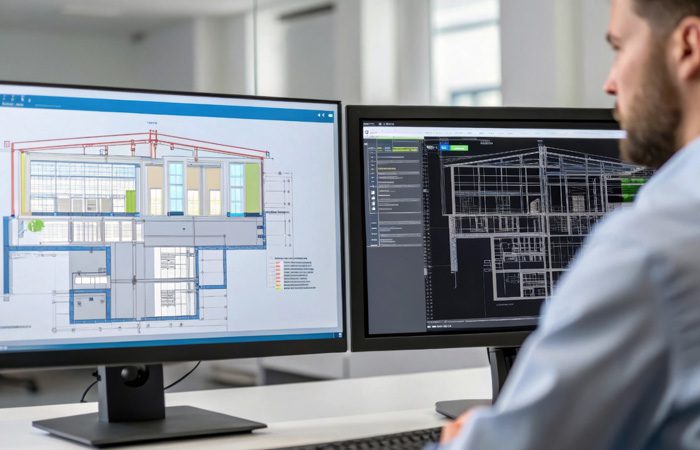
How BIM is Revolutionizing Architectural Planning?
Architectural planning has always been at the heart of the built environment—where ideas are translated into physical spaces that shape how we live, work, and interact. Traditionally, this process relied on manual drafting, 2D CAD drawings, and fragmented collaboration between architects, engineers, and contractors. While these methods served their purpose, they often led to inefficiencies: miscommunication, design conflicts, cost overruns, and delays.
Enter Building Information Modeling (BIM)—a digital methodology that is reshaping architectural planning at its very core. BIM is not just a tool for creating 3D models; it is a comprehensive process that integrates design, engineering, construction, and facility management into one intelligent ecosystem. For architects and planners, this represents nothing short of a revolution—one that aligns precision, creativity, sustainability, and efficiency.
Why BIM is Transforming Architectural Planning
The adoption of BIM in architectural planning is being driven by a confluence of industry needs and technological possibilities. Some of the biggest shifts include:
- From 2D Drawings to Intelligent 3D Models
BIM replaces static blueprints with interactive 3D models enriched with data about materials, systems, costs, and performance. This enables architects to visualize every aspect of a building long before construction begins, minimizing ambiguities. - Seamless Collaboration Across Disciplines
BIM platforms create a shared digital environment where architects, engineers, contractors, and clients can collaborate in real time. Clash detection and coordination tools ensure that structural, mechanical, electrical, and plumbing systems integrate seamlessly—reducing rework. - Improved Accuracy and Risk Mitigation
With BIM, planning errors and omissions are drastically reduced. Changes made to one part of the model automatically update across drawings and schedules, ensuring consistency. This reduces costly site changes and project risks. - Data-Driven Decision Making
Architectural planning with BIM is no longer guesswork. Planners can analyze energy performance, daylighting, acoustics, and sustainability metrics before a single brick is laid, supporting green building certifications and long-term operational efficiency. - Lifecycle Value Creation
BIM extends beyond design and construction. For facility owners, it provides a digital twin of the building—enabling efficient operations, predictive maintenance, and asset management for decades after project completion.
BIM in Architectural Planning: Key Applications
BIM is touching nearly every aspect of architectural planning. Let’s explore how:
- Conceptual Design and Visualization
BIM tools empower architects to create parametric 3D models that adapt dynamically as design elements change. This allows for rapid iteration of design options, helping clients visualize concepts early and participate in decision-making.
- Detailed Design and Documentation
Gone are the days of static drawings. BIM generates construction-ready documentation directly from models, including floor plans, sections, and elevations. Every update is automatically reflected, ensuring consistency and accuracy.
- Space and Layout Optimization
Architects use BIM to simulate space utilization, ensuring efficient layouts for residential, commercial, or public projects. It helps balance aesthetics with practical considerations like accessibility, circulation, and compliance.
- Energy and Sustainability Analysis
With built-in simulation capabilities, BIM enables analysis of building orientation, material efficiency, HVAC loads, and daylight penetration. This helps architects design sustainable, high-performing buildings aligned with green certifications.
- Clash Detection and Coordination
Architectural planning no longer operates in isolation. BIM allows for early identification of clashes between architectural elements and structural/MEP systems—resolving conflicts before they reach the construction stage.
- Heritage and Reverse Engineering
Scan-to-BIM technologies allow architects to capture existing conditions of heritage or legacy buildings and create accurate 3D models. These can be used for renovation, adaptive reuse, or expansion projects.
The Strategic Impact of BIM in Architectural Planning
BIM’s influence goes beyond operational efficiency—it is reshaping the business of architecture.
- Cost Control: Accurate quantity take-offs and cost estimates derived from BIM models allow better budget forecasting and value engineering.
- Time Efficiency: Early clash detection and streamlined coordination accelerate project timelines.
- Client Confidence: Immersive visualizations and virtual walkthroughs enhance client engagement, improving approval cycles.
- Compliance and Standards: BIM aligns with international codes, permitting smoother regulatory approvals.
- Future Readiness: By enabling digital twins, BIM ensures that architectural plans support long-term asset management.
TAAL Tech’s Role in BIM-Enabled Architectural Planning
At TAAL Tech, BIM is not just an add-on—it is embedded in the way we deliver architectural planning services. Our expertise spans the entire lifecycle of a building, from concept design to digital asset management.
Our BIM & Architectural Planning Services
- Architectural Planning and BIM Modeling: Creation of parametric models, permit-ready drawings, and coordinated layouts.
- Design Development and Detailing: Production of comprehensive construction documents, including sections, elevations, and schedules.
- Clash Coordination: Ensuring architectural plans integrate seamlessly with structural and MEP systems.
- Interior Design & Fit-Out Detailing: Accurate 3D visualization, renderings, and walkthroughs for client approval.
- Reverse Engineering (Scan-to-BIM, CAD-to-BIM, PDF-to-BIM): Bringing legacy assets into the digital era.
- Heritage Building Documentation: Preserving cultural assets through precise digital modeling.
Why TAAL Tech?
- Domain Expertise: Years of experience in delivering BIM-enabled architectural solutions across industries.
- Global Standards Compliance: Alignment with international codes, permitting, and client expectations.
- Integrated Approach: Collaboration across disciplines ensures cohesive, clash-free models.
- Cost-Effective Delivery: Hybrid offshore-onshore models that maximize value while ensuring quality.
- Future-Ready Mindset: Supporting clients with digital twins and asset management strategies.
With these capabilities, TAAL Tech empowers architects, developers, and facility owners to not just design better buildings, but to design smarter, sustainable, and future-ready spaces.
Future of Architectural Planning with BIM
The future of architecture is inseparable from BIM. As technologies like AI, IoT, AR/VR, and digital twins converge with BIM, architectural planning will become even more immersive and intelligent. Imagine clients exploring virtual walkthroughs of their projects before approval, or AI-driven models suggesting sustainable materials based on performance data.
Key trends to watch include:
- Integration with Smart Cities: BIM models becoming building blocks of city-scale digital twins.
- Augmented Reality in Planning: Onsite AR overlays helping planners validate designs in real-world conditions.
- Sustainability by Default: BIM tools increasingly embedding carbon footprint analysis and lifecycle assessments.
- AI-Powered Design Assistance: Automated optimization of layouts, facades, and energy efficiency.
BIM is not simply revolutionizing architectural planning—it is redefining the very practice of architecture. From concept to construction to facility management, BIM creates a connected ecosystem where creativity, efficiency, and sustainability thrive together.
For architects, this means more than adopting a new tool—it requires embracing a new mindset, one where collaboration, data-driven insights, and lifecycle thinking take precedence.
At TAAL Tech, we stand at the forefront of this transformation, helping clients leverage BIM to design and deliver smarter spaces that meet today’s demands and tomorrow’s possibilities.
The future of architecture is digital, and BIM is the blueprint.


